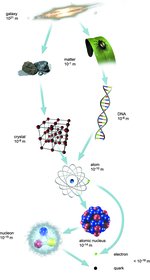Structure of Matter
What we know...
When making our way into the innermost regions of matter, we first meet crystal lattices or molecules before reaching the level of atoms. In the 20th century, physicists were able to prove that atoms are not indivisible, but are instead composed of an extended electron shell and a compact atomic nucleus. The nucleus itself consists of positively charged protons and of neutrons, which carry no charge. Together, these particles are designated as nucleons. They are part of a larger family of particles called hadrons.
Around 30 years ago, we discovered that nucleons and all other hadrons also possess an inner structure. The particles that make up this structure are called quarks, and are today viewed as the fundamental building blocks of matter, along with electrons.
The matter in and around us is therefore structured as a hierarchy of various composite systems covering almost 40 orders of magnitude in size, from galaxies and macroscopic matter that we can touch, all the way to the elementary particles - the quarks and electrons.
Different binding forces hold the systems together in the various hierarchies. While processes on the macroscopic level are governed by the force of gravitation, the prominent force at the atomic level is the electromagnetic attraction between the negatively charged electrons and the positive atomic nuclei. The atomic nuclei, in turn, are held together by the so-called strong force, which acts between the quarks within the nucleons and also is responsible for the binding of nucleons in nuclei. In addition, there is the weak force, which is just as important for the creation of matter, since, by the way of radioactive decay, it allows the transformation of nuclei.
...and what we would like to know
Even if we know what the basic building blocks of the universe are, we still have a long way to go until we can describe the complex properties of matter and its various manifestations. One reason for this is that we still know too little about the fundamental forces and their underlying symmetries. This is especially the case with the strong force acting between quarks and between nucleons, a force that still retains many mysteries.
The second reason can be best explained with the expression: The whole is more than the sum of its parts. The various manifestations of matter are the result of a complex interaction between many of its component parts. Since the creation of the universe, this complex interaction has produced various metamorphoses of matter that have brought about increasingly larger and more complex structures.
FAIR is intended to help us solve the puzzle posed by the structure of matter.
Unlike electrons, quarks do not exist in nature as isolated particles. Instead, they are always linked to each other in groups of two or three.
- Why do quarks never exist in isolation?
Protons and neutrons contain three quarks each. Strangely enough, however, the mass of the elementary quarks accounts for less than two percent of the mass of the nucleons.
- Why are protons and neutrons so much heavier than their constituents?
There are about 300 different stable nuclei here on earth. The universe, however, is home to a much larger group of unstable atomic nuclei (probably over 6,000) that transform into stable nuclei by means of radioactive decay.
- In what ratios of protons to neutrons can nuclei exist? What new properties do highly unstable nuclei reveal?
The forces that act on the basic building blocks of matter are subject to specific symmetries that fundamentally influence the structure of matter and the development of the universe.
- What fundamental symmetries govern the laws of nature? When, and with what consequences, do violations of such symmetries occur?




